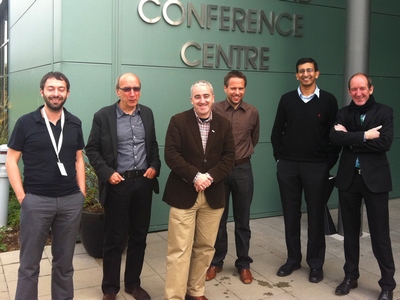
In order to demonstrate the state of the art in labor supply modeling and to compare the performance of quasi-experimental techniques with the established structural models, IZA invited about 20 top international researchers to a workshop in Dublin on May 18-19. The workshop was jointly organized by IZA Director of Labor Policy Hilmar Schneider, IZA Senior Research Associate Andreas Peichl and IZA Visiting Research Fellow Olivier Bargain (University of Aix-Marseille II). The workshop was organized in association with the European Meeting of the International Microsimulation Association, which was part of the European City of Science hosted by Dublin in 2012.
In the first keynote speech, Richard Blundell (UCL/IFS and IZA) emphasized the importance of labor supply for consumption smoothing as a response to shocks. The aim of the paper was to understand the transmission mechanisms from wage shocks to consumption and labor supply decisions of two partners in a family. He showed that female labor supply plays an important role in smoothing permanent shocks to male wages. This indicates a substitutability of consumption and hours. In his empirical work, he found little evidence that external sources of insurance (such as savings, networks or government policies) matter for consumption smoothing.
Raj Chetty (Harvard University and IZA) delivered the second keynote speech of the workshop. He introduced a new methodological strategy to uncover the effect of the U.S. Earned Income Tax Credit (EITC) on earnings. Assuming that households living in areas with low levels of knowledge about the tax credit behave as if the policy did not exist, Chetty compared these low-knowledge households to households living in neighborhoods with widespread knowledge of the tax system. The very innovative and promising approach shows that households adjust their labor supply behavior in response to the EITC and considerably increase their earnings.
Apart from the keynotes, the workshop consisted of four sessions. The first session was on measuring the labor supply responses to policy changes. The researchers in the other sessions of the workshop mostly confirmed that tax payers adjust their labor market behavior to changing tax policies. While James Ziliak (University of Kentucky) estimates positive average elasticities of taxable income, Hakan Selik (Uppsala University) demonstrated for Sweden that observed positive elasticities are mostly due to self-employed workers who can more flexibly adjust taxable income through working hours.
Besides looking at quasi-experimental evidence to uncover the effect of tax policies on labor supply adjustments, another focus of the workshop was to compare the performance of long established structural models to natural experiments such as tax reforms. The presentations by Trine Vatto (Statistics Norway) and Jorgen Hansen (Concordia University and IZA) showed that carefully designed structural models are able to capture the true effect and match the quasi-experimental data quite well.
The last part of the workshop considered labor supply in a dynamic context. Using variation in the Austrian pension system with regard to the early retirement age (ERA), Andrea Weber (University of Mannheim and IZA) finds that extensive margin elasticities are quite large. Both men and women significantly respond to increases in the ERA and delay pension claims and job exits. Moreover, she presented evidence on spill-over effects on individuals not directly affected by the pension reforms. In addition to estimating the extent of behavioral responses to policy reforms, Alexander Gelber (University of Pennsylvania) has carried out research on the speed of adjustment to changes in the tax-benefit system. Exploiting a change in the U.S. Social Security Earnings Test he finds that the adjustment period takes one or two years at most.
Closely related to the adjustment of labor market behavior are the dynamics of life-cycle behavior that is affected by public policies. Johannes Geyer (DIW Berlin) presented his research on a recently introduced parental leave reform in Germany that pays higher benefits for a shorter period of time. He finds that mothers’ labor supply declines in the first year after childbirth, but increases in the second year due to the reform. Victoria Prowse (Cornell University and IZA) analyzed a cut in the generosity of unemployment insurance in Germany. She showed that a reduction in the entitlement period generates larger increases in employment than a reduction in the replacement ratio. Monica Costa Dias (Institute for Fiscal Studies and IZA) analyzed the long-term effects of in-work benefits in a life-cycle model of women's labor supply, human capital formation and savings for policy evaluation. She finds small but non-negligible anticipation effects on employment and education to recent policy reforms in the UK like the extension of the Working Families Tax Credit.
At the end of the workshop, Hilmar Schneider presented the “NEUJOBS” research project. Together with 28 partner institutes and universities, IZA is a key contributor to this project, which is funded by the European Commission under the 7th Framework Program. The objective of NEUJOBS is to analyze possible future developments of the European labor markets under the main assumption that European societies are facing major transitions that will have a strong impact on employment. IZA’s contribution to the NEUJOBS project is to model structural and behavioral aspects of labor supply and demand in order to shed light on the important question how employment in European labor markets will evolve until 2025 or even beyond.
The workshop clearly showed that research on labor supply behavior has made tremendous progress. Among the different approaches to evaluate the labor supply effects of policy reforms, researchers need to carefully scrutinize which identification strategy is best suited for their research question. High unemployment rates in many European labor markets point to the need to improve labor market institutions, including tax and transfer systems. Credible research results can help policy makers to improve labor market regulations and to achieve the intended policy goals. IZA is determined to stay at the forefront of research in this area and to organize future workshops on this topic.
View the conference program online.